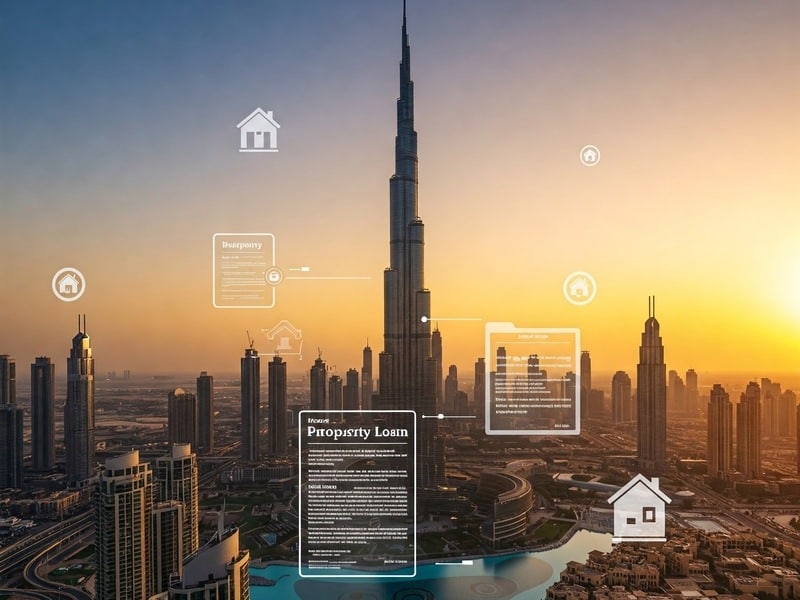What is a Mortgage Transfer and Why Do People Consider It?
In Dubai’s dynamic real estate market, mortgage transfer is becoming an increasingly popular financial strategy. Simply put, a mortgage transfer involves shifting an existing home loan from one bank to another, or transferring the loan to a new buyer when selling a mortgaged property. Property transfers in Dubai encompass not only mortgage transfers but also other types of ownership changes, each requiring specific legal and procedural steps.
Homeowners and investors often consider a mortgage transfer to:
- Benefit from better mortgage rates Dubai.
- Access lower monthly installments.
- Refinance to release equity from the property.
- Switch to a real estate broker with better service or flexible terms.
- Contact property experts for more information.
Mortgages are a key financial tool in Dubai’s real estate market, making the transfer process an important consideration for both buyers and sellers.
With Dubai’s competitive lending environment and fluctuating interest rates, transferring a mortgage can be a smart financial move — but it requires careful planning and approval from the mortgage lender, who is directly involved in the process.
Property Ownership and Mortgaged Property
Property ownership in Dubai is governed by strict regulations to ensure transparency and security for all parties involved. When it comes to mortgaged property, the process of transferring property ownership requires special attention. A mortgaged property is one where the lender retains a legal interest in the property until the mortgage loan is fully paid. This means that the Dubai Land Department (DLD) must be involved in every transaction related to transferring property ownership, whether the property is fully paid or still under mortgage.
The Dubai Land Department DLD oversees all property transactions, ensuring that the rights of both the lender and the property owner are protected. If you are considering transferring a mortgaged property, it’s essential to understand that the lender’s approval is required before any ownership changes can be registered. The DLD will only process the transfer once all outstanding dues are settled and the lender issues the necessary clearances. This ensures that the property’s title deed accurately reflects the current ownership status and any existing mortgage.
Whether you are buying, selling, or refinancing, understanding the role of the Dubai Land Department and the implications of a mortgaged property is crucial for a successful transaction. Always verify the property’s mortgage status and ensure all steps are followed according to DLD regulations to avoid delays or complications in the property transfer process.
Types of Mortgage Transfers in Dubai

In Dubai, there are two primary types of mortgage transfers:
1. Transfer to Another Bank (Mortgage Buyout):This option allows homeowners to shift their existing mortgage to another bank offering more attractive interest rates or better terms. This is especially useful if mortgage rates in Dubai have dropped since the original loan was signed.
2. Transfer to a New Buyer (Mortgage Assumption or Settlement):You can sell a mortgaged property in Dubai, and the sale process involves specific steps to ensure all legal and financial obligations are met. When selling a property that is mortgaged, the outstanding loan can either be cleared by the seller or assumed by the buyer (with the lender’s approval). The process requires coordination between all parties, including the buyer, seller, buyer’s bank, and seller’s bank, to ensure a smooth property transfer.
Each method involves specific paperwork and approval procedures, making it essential to work with a trusted mortgage broker Dubai who understands the process and the requirements for mortgages in Dubai.

The mortgage transfer process in Dubai, while straightforward, must follow legal and financial steps precisely, and all parties (buyer, seller, banks) must be present or represented for a smooth property transfer.
Step 1: Check Current Mortgage TermsBefore initiating a transfer, review your existing loan agreement. Some banks impose early settlement fees, which must be factored into your decision, along with any legal fees that may apply.
Step 2: Compare New Mortgage OffersUse a reliable mortgage loan calculator Dubai or a mortgage calculator Dubai to estimate monthly payments, interest costs, and savings with new offers.
Step 3: Get Pre-Approval from New BankIf switching banks, obtain pre-approval from your desired new lender. For buyers, the buyer’s bank will assess the property and approve the mortgage, ensuring the buyer’s interests are protected. The property may be blocked in the buyer’s name during this process.
Step 4: Request a Liability LetterRequest a liability letter from your current bank, which states the outstanding mortgage balance or outstanding loan balance and loan closure conditions. This letter is valid typically for 15–30 days and is required to proceed with the sale or transfer.
Step 5: Arrange for Payoff or Buyer Financing
- If refinancing: the new bank pays off your existing loan.
- If selling: the buyer must settle the liability (either by cash or fresh mortgage). The seller’s mortgage must be cleared with the seller’s bank, and a clearance letter must be obtained to confirm the mortgage has been fully paid. The remaining balance or remaining amount must be paid to the lender before the property can be sold and the new title deed issued. Only after paying the outstanding mortgage balance will the property be released for transfer.
Step 6: Dubai Land Department ProcessIn Dubai, all property ownership changes must be registered with the Dubai Land Department (DLD). Registering the property transfer requires payment of registration fees and applicable fees at the dld registration trustee’s office. You may also need to provide a land map or unified map, depending on the property’s location. If you are interested in renting apartments in Dubai, the process and legal requirements differ, especially concerning tenancy registration and expat considerations. Some transactions can be registered on the same day if all documents and payments are in order.
Step 7: Registration and New Mortgage SetupAfter the old loan is cleared and all fees are paid, the property is either transferred to the new owner (if selling) or re-mortgaged to the new lender (if refinancing). The new title deed and updated title deeds are issued after final approval by the DLD.
Final Step:The final step is to register the property transfer at the DLD. The process is only complete after all applicable fees, registration fees, and legal fees are paid and all approvals are granted.
Special Considerations:There may be special considerations for property transfers between family members, or if the transaction involves Islamic mortgages, which may require additional steps or documentation.
A smooth property transfer depends on coordination between all parties and careful attention to the property’s details, mortgages, and the sale process.
Required Documents for Mortgage Transfer
To ensure a smooth mortgage transfer in Dubai, gathering the required documents is a critical first step. The process begins with the original title deed of the property, which serves as proof of ownership. Both the buyer and seller must provide a valid passport, and residents are also required to submit their Emirates ID. For non-residents, a valid passport is sufficient.
A key document in the mortgage transfer process is the No Objection Certificate (NOC) from the current lender, confirming that the lender has no objection to the transfer. Additionally, a letter from the new bank confirming the mortgage registration is necessary, along with three certified mortgage contracts signed by both parties. If the property owner cannot be present, a power of attorney may be required to authorize a representative to act on their behalf.
The DLD registration trustee’s office will provide guidance on any additional documents needed, ensuring that all paperwork is in order for a successful property transfer. Having all the required documents ready not only speeds up the process but also helps avoid unnecessary delays or complications during the mortgage transfer.
Costs Involved in Mortgage Transfer
Transferring a mortgage in Dubai comes with certain costs. Here’s what you should budget for:
- Bank Early Settlement Fees: 1% of the outstanding loan amount or AED 10,000 (whichever is lower).
- New Mortgage Arrangement Fee: Usually 0.5% to 1% of the loan amount.
- Property Valuation Fee: AED 2,500 to AED 4,000 depending on the bank.
- Dubai Land Department Registration Fees: 0.5% for mortgage registration on refinancing or higher if selling. These registration fees and other applicable fees must be paid to the DLD or through approved payment channels such as Dubai Pay, Noqodi platform, or ePay gateway.
- Processing and Admin Fees: Nominal charges for document handling and registration.
- Legal Fees: Legal fees may also apply, depending on the complexity of the transaction.
If you are selling a mortgaged property, the remaining amount of the loan must be paid to the lender before the transfer can proceed. Paying all required fees and charges on time is crucial to avoid delays in the process.
Always factor these into your cost-benefit analysis before proceeding.
Objection Certificate: What It Is and Why You Need It
An Objection Certificate, commonly referred to as a No Objection Certificate (NOC), is a vital document in the mortgage transfer process for any mortgaged property in Dubai. This certificate is issued by the lender or the property developer and confirms that there are no outstanding payments, service charges, or other dues related to the property. Without an Objection Certificate, the Dubai Land Department will not proceed with the transfer of ownership.
For sellers, obtaining the NOC is a crucial step before selling a mortgaged property. It assures the buyer and the DLD that all financial obligations have been met and that the lender has no objection to the transfer. Buyers should always verify that the seller has secured the NOC to avoid inheriting any unpaid liabilities. The NOC protects both parties and ensures a transparent, hassle-free mortgage transfer, making it an indispensable part of the property transfer process in Dubai.
Things Homeowners and Investors Should Know Before Making the Move

1. Time It Right:If mortgage rates Dubai are falling, refinancing can save money. Conversely, if rates are rising, it may not be worth it.
2. Use Mortgage Calculators:Tools like a mortgage calculator Dubai or home loan calculator Dubai can help you estimate savings quickly.
3. Choose the Right Mortgage Broker: An experienced mortgage broker Dubai can navigate the complex paperwork and negotiate better deals on your behalf. For more guidance, check out this comprehensive guide for first-time buyers entering Dubai’s real estate market in 2025.
4. Understand Your Financial Goals:Are you seeking lower monthly installments, quicker loan payoff, or cash-out refinancing? Knowing your goal will guide your decision.
5. Compare Offers from Different Banks:Switching to a different bank can provide better interest rates, improved terms, or additional banking benefits. Always compare offers before making a decision.
6. Beware of Hidden Charges:Request a full fee breakdown from both your current and future lender.
7. Plan Your Timeline:Mortgage transfer can take between 2–6 weeks depending on documentation and bank processing times.
8. Special Considerations:Be aware of special considerations such as unique requirements for Islamic mortgages, or if you are a non-resident buyer. These scenarios may involve different procedures or additional bank obligations.
By following these tips and addressing any special considerations, you can help ensure a smooth property transfer.
Expert Tips for a Smooth Mortgage Transfer
Achieving a smooth mortgage transfer in Dubai requires attention to all the details and strategic planning. Start by checking with your current lender for any prepayment penalties that may apply if you settle your existing mortgage early. It’s wise to compare at least three new mortgage offers from different banks to secure the most favorable terms for your new mortgage.
Negotiating the processing fee with your new bank can help reduce overall costs, so don’t hesitate to ask for better terms. Before finalizing the transfer, confirm whether the new interest rate is fixed or variable, as this can significantly impact your future payments. Maintaining a strong repayment history with your current lender can also improve your chances of approval with a new bank.
Finally, consider the timing of your mortgage transfer carefully. Avoid transferring during periods of rising interest rates, and plan your move when market conditions are most favorable. By following these expert tips, you can ensure a smooth mortgage transfer and maximize the benefits of your new mortgage arrangement.
FAQ’s
Q. What is a mortgage transfer in Dubai?
A. It is the process of moving an existing mortgage to a different lender or assigning it to a new property buyer. The final step is to register the new ownership with the Dubai Land Department (DLD). The property is officially sold when the title deeds are updated and transferred to the new owner.
Q. Is transferring a mortgage cheaper than early settlement?
A. It can be — especially when mortgage rates have dropped, making refinancing attractive.
Q. How long does a mortgage transfer take in Dubai?
A. Typically between 2 to 6 weeks, depending on banks and DLD registration processing. The process includes registering the property with the DLD and obtaining final approval from the Dubai Land Department to complete the transfer.
Q. Are there penalties for mortgage transfers?
A. Yes, usually an early settlement fee charged by your current bank.
Q. Should I use a mortgage broker for a transfer?
A. Yes, a mortgage broker Dubai can simplify the process and help you find better deals.
Conclusion
In conclusion, transferring property ownership in Dubai, particularly for mortgaged properties, involves a series of well-defined steps and requires careful planning. Understanding the process, gathering all required documents, and recognizing the role of the Dubai Land Department are essential for a successful mortgage transfer. The importance of obtaining an Objection Certificate cannot be overstated, as it ensures all outstanding payments are cleared and the transfer can proceed without issues.
By following this step-by-step guide and applying expert tips, you can achieve a smooth mortgage transfer and secure your property ownership with confidence. Always consult with relevant authorities and seek professional advice to navigate the process efficiently, ensuring that your property transactions in Dubai are completed seamlessly and in compliance with all regulations.
A mortgage transfer can be a smart move for Dubai homeowners and investors looking to optimize their property finance strategy. However, it’s essential to understand the full costs, timelines, and benefits before making a decision.Consult trusted mortgage advisors, use tools like a mortgage loan calculator Dubai, and stay informed about current mortgage rates Dubai trends. With the right planning, you can save significantly and make your next property move in Dubai a successful one!






